Okay, it's time for me to stop trying to listen to more 2016 albums and just wrap up this list. In the past I would split my jazz list into a new releases part dedicated to current recordings and a historical part combining first releases of archival material with reissues. This year I'm skipping reissues, partly because some projects were so gargantuan that little guys like me weren't serviced with them, partly because the vinyl renaissance means everything is being reissued at once, and partly because so much stuff is just rehashing the same material in new packaging, with or without a gimmick or a little additional material added. So first releases of archival material are lumped in here. Maybe that's not entirely fair to the current guys, but on the other hand I don't include many archival items on my list.
1. Matthew Shipp & Bobby Kapp: Cactus (Northern Spy)
Two generations of free jazz combine for this duo: drummer Kapp, from the '60s; pianist Shipp, from the '90s (Shipp previously played on a Kapp-led band album). There's a greater-than-usual sense of Shipp having fun, and sounds I haven't heard from him quite how they appear here -- such as the quiet lyricism of "During," which Kapp counterpoints with a semi-martial beat that somehow is perfectly apt. Kapp has what some drummers tragically lack -- taste! -- as well as stylistic flexibility. Completely improvising each track, their telepathic interaction is one of the joys of this record. Without making any compromises ("Snow Storm Coming" sure isn't lightweight), this is one of the most immediately accessible free-improv albums I've ever heard. [Note: I manage the ESP-Disk' label, which has released albums including each of these artists.]
 2. Joe Morris: Shock Axis (Relative Pitch)
2. Joe Morris: Shock Axis (Relative Pitch)
If this album came from a guitarist I didn't know as a jazz guy, I might categorize it as metal; the trio of electric guitar, electric bass (Chris Cretella), and drums (Dave Parmelee) makes music far more texturally dense and intense than most jazz, though of course it has its roots in the sort of free-improvisation Sixties free jazz a la Albert Ayler and Frank Wright, with Morris's guitar in the roll of the tenor saxophone but wreaking even more sonic mayhem. The album is great, but it's only about 50% of the impact this group's huge sound makes in person. [Note: Morris is another conflict of interest for me, though at least not a current ESP artist.]
 3. David S. Ware & Matthew Shipp Duo: Live in Sant'Anna Arresio, 2004 (AUM Fidelity)
3. David S. Ware & Matthew Shipp Duo: Live in Sant'Anna Arresio, 2004 (AUM Fidelity)
That we can receive previously unreleased Ware four years after his passing would be a blessing under any circumstances; that it is his first duo release that I am aware of, with longtime DSW Quartet pianist Shipp, makes it inherently interesting; most of all, it is Ware at his peak of musical imagination. Shipp is no slouch in the musical imagination department either, and is clearly inspired by working with Ware in this challenging context. Here they are both powerhouse players of incredible stamina, but there is also a distinct effort made to vary the dynamics and density of the textures they're putting forth, and their timbres as well -- Ware, of course, was a master of intense tenor sax tones -- making this 46-minute concert a stimulating and engrossing listen.
 4. Ivo Perelman/Karl Berger: The Hitchhiker (Leo)
4. Ivo Perelman/Karl Berger: The Hitchhiker (Leo)
Brazilian tenor saxophonist Perelman's 2016 output included two quartet albums and three duos (and another six that came out in Europe last year but aren't available in the U.S.A. until this year -- reviews soon to come). I could have made half of this list be Perelman albums, but confined myself to one album per artist and chose this one to represent Perelman because Berger isn't already on this list, unlike Matthew Shipp and Joe Morris, who each had a duo album and a quartet album with Perelman -- and because it distinguishes itself from Perelman's other activity. A major figure on the New York avant-jazz scene since the mid-'60s, Berger plays vibraphone here after a previous duo with Perelman as a pianist. A thoughtful and broadly experienced player, Berger straddles 'inside' and 'outside' playing and seems to innately structure even his free improvisation; this is a more tonal album than most of Perelman's releases , and all the more interesting for letting us hear Perelman in such a context -- though for his 'out' side, there's the solo sax (actually, just sax mouthpiece) track "Pride and Prejudice"; Berger also gets a solo track, the tellingly titled "Extremely Loud While Incredibly Quiet." There's a quiet playfulness to their interaction ("Twilight" is a good example of this) that is especially attractive.
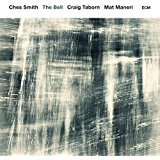 5. Ches Smith/Craig Taborn/Mat Maneri: The Bell (ECM)
5. Ches Smith/Craig Taborn/Mat Maneri: The Bell (ECM)
Smith, the leader on this session, composed all the tracks and is the drummer. He's no ordinary drummer, though, and this is no ordinary trio session. Smith often uses his drums as pitched instruments and for timbre, and I'm not just referring to his occasional inclusion of vibraphone and timpani; he scrapes his cymbals for eerie sustained tones, plays his toms melodically, and is an equal member of the ensemble rather than a time-keeper (though he could groove if he wanted to, as his solo starting at 8:52 and the rest of "Isn't It Over?" prove). Maneri, here on viola, as usual plays microtonally and is one of the most expressive players around; I couldn't say he's expressing specific emotions, but his slippery sound seems to speak profoundly beyond words; he and Smith are a perfect match in sensibility. Taborn, long one of my favorite pianists for his unclichéd approach to the instrument, is lyrical or abstract by turns but never does anything that sounds like another jazz pianist; here he often grounds the group as the others swirl around him, and he has the knack of playing very simple parts that are exactly what the music needs and not an iota more. Though there are moments of vehemence, as on the end of "I'll See You on the Dark Side of the Earth," there's often a sense of space between everybody's notes here that hints at Zen koans and philosophical enigmas probed through meditative intuitions. It's a very ECMish album.
 6. Donny McCaslin Group: Beyond Now (Motema)
6. Donny McCaslin Group: Beyond Now (Motema)
This year's Kamasi Washington, in the limited sense of a jazz guy getting way more exposure than usual thanks to an association with a big name outside the jazz realm. In the case of saxophonist McCaslin, it's because he and his band featured prominently on David Bowie's Black Star. McCaslin dedicated this album to Bowie, and even plays Bowie's instrumental "Warszawa" and, with guest vocalist Jeff Taylor, "A Small Plot of Land." There are some other non-jazz covers as well: Deadmau5's "Coelacanth 1" and MUTEMATH's "Remain." Even these are a good fit, since McCaslin's jazz is more electric (largely thanks to keyboardist Jason Lindner) and modern in its rhythms (drummer Mark Guiliana) than what purists might like. (But hey: lol@purists.) Presumably it was precisely this group's outside-the-box thinking about genre that attracted Bowie in the first place, and while their playing here is more jazz-oriented than on Black Star, open-minded non-jazz listeners shouldn't find it difficult to relate to.
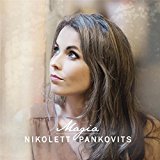 7. Nikolett Pankovits: Magia (self-released)
7. Nikolett Pankovits: Magia (self-released)
This might be the most hybridized album I heard this year (Zorn [#9] is beyond hybrid into sonic collage]; much of it is Latin jazz takes on Hungarian cabaret and folk music. The first track is a Hungarian folk song Béla Bartók arranged; there are two more collected by Zoltán Kodály, with one of these given Spanish lyrics by Pankovits's husband, guitarist Juancho Herrera, who had a hand in all the arrangements besides the Bartok one. A cabaret song with lyrics by Hungarian author Mária Szepes (under the pen name Maria Orsi), is sung in Hungarian and in Pankovits's English translation as "Don't Ask Me Who"; we also hear the most famous Hungarian song, "Gloomy Sunday," in both languages. Pankovits can do straight-ahead jazz as well, shown by her take on Johnny Mandel's "Where Do You Start?" with the stripped-down accompaniment of pianist Jason Lindner and saxophonist Greg Tardy. The most promising sign, though, is the sole original on the album, Pankovits's "Stop for a Moment," with sophisticated harmonies over a cool Latin ballad groove and the album's most uninhibited solos, especially those of Herrera and trumpeter Josh Deutsch. Beautifully moody, this is a most impressive debut.
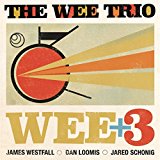 8. The Wee Trio: Wee+3 (Bionic)
8. The Wee Trio: Wee+3 (Bionic)
James Westfall (vibes), Dan Loomis (bass), and Jared Schonig (drums) are joined by guests Nicholas Payton (trumpet), Nir Felder (guitarist), and pianist Fabian Almazan on three tracks each. The core trio is by itself on two tracks, one of them a cover of Meshell Ndegeocello's "Lola." All other tracks are written by trio members. My favorites are the ones with Felder, who sounds like a Pat Metheny acolyte; the album closer, "Apparition," is particularly thrilling. Speaking of Metheny, most everything here has the heartland melodicism that the original Pat Metheny Group delivered, but wrapped in the more intricate structures and rhythms typical of the younger generation of mainstream jazzers nowadays, though with more New Orleans flavor on the tracks with Payton, especially "Belle Femme de Voodoo.".
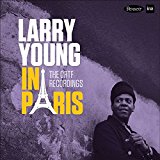 9. Larry Young: In Paris: The ORTF Recordings (Resonance)
9. Larry Young: In Paris: The ORTF Recordings (Resonance)
It practically goes without saying that this two-disc set is great, because organist Young always was. He'd already established himself with classic albums on Prestige and Blue Note by the time of these 1964-65 sessions for French radio. He died young (of pneumonia at age 38), so every bit of his genius is treasured. He'd come out of bebop but was starting to make his style more modal in this period, and really stretches out on a few of these pieces (switching to piano for one, which is of great interest). And on seven of the ten tracks here, the horns include trumpeter Woody Shaw and underrated tenor saxophonist Nathan Davis, so there's great playing all around. Kudos to Resonance for packaging this invaluable material superbly, with lots of photos and insightful interviews with Young's peers and collaborators.
 10. Gebhard Ullmann/Achim Kaufmann: Geode (Leo)
10. Gebhard Ullmann/Achim Kaufmann: Geode (Leo)
I don't know if it's fair to say 2016 was the year free jazz got quiet or whether that's just what attracted me most at this point in my life, but here's another example, though with its moments of vehemence. Ullmann (tenor sax, bass clarinet) and Kaufmann (piano) are longtime favorites, and together they make spontaneous music of subtle intensity. My favorite track is "Bone, Gristle and Quartz," on which Kaufmann plays prepared piano and inside on the strings to create a miniature gamelan orchestra over which Ullmann plays with sounds (sometimes just breathe going through the horn with no notes produced) for sounds' sake. Each player also takes a solo track, increasing the intimacy of the music. More conventional tracks are still quite exploratory on this rewarding album for attentive listeners.
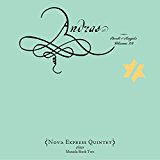 11. Nova Express Quintet: Andras: Book of Angels vol. 28 [John Zorn: Masada Book Two] (Tzadik)
11. Nova Express Quintet: Andras: Book of Angels vol. 28 [John Zorn: Masada Book Two] (Tzadik)
The prolific John Zorn often defies genre boundaries; though there is no doubt in my mind that this instrumental album can safely be filed in jazz, it's jazz in a distinctly Zornish style drawing on influences including classic Ornette Coleman, the modes of Jewish folk and cantorial music, tango, Ennio Morricone, spy movie soundtracks, '50s exotica, the Modern Jazz Quartet, hard bop, and the sinister sound of the organ on "Keresin" (a la Gregg Rolie on Santana's Caravanserai) -- and that's just the first four tracks! The point, of course, is that it is immediately identifiable as Zorn. John Medeski (piano, organ), Kenny Wollesen (vibraphone), Trevor Dunn (acoustic and electric basses), Joey Baron (drums), and Cyro Baptista (congas, percussion) comprise Nova Express Quintet; all have collaborated with Zorn many times and proven adept at the turn-on-a-dime style switches his music requires. This is Zorn at his most melodic and accessible.
 12. Gary Monheit/Dan Krimm: New Shoots (Another Pass)
12. Gary Monheit/Dan Krimm: New Shoots (Another Pass)
With drummer Scott Amendola (Nels Cline Singers, Charlie Hunter, and his own Scott Amendola Band), this Bay Area group is a piano trio, but with the significant difference that Krimm plays fretless electric bass rather than the usual acoustic upright. Krimm's melodic bass lines recall Scott La Faro and Steve Swallow, especially on his own tunes -- Krimm and Monheit wrote four tracks each on this, their third album (Krimm's 1986 debut, Sentience, and a 2010 co-bill, Fortune Smiles). Monheit's piano playing sounds like a cross between McCoy Tyner's chording and Lyle Mays's right-hand lyricism, so this is a very tuneful and immediately appealing album of straight-ahead jazz that I like more each time I play it. - Steve Holtje
Reviews of #1 and #9 first appeared in the magazine The Big Takeover.
